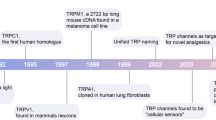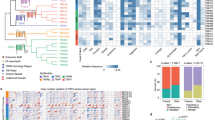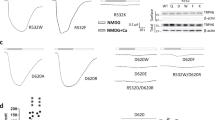Abstract
The transient receptor potential (TRP) superfamily contains at least 28 homologs in mammalian. These proteins form TRP channels are permeable to monovalent and divalent cations and participate in a variety of physiological functions. Dysregulation of TRP channels is responsible for numerous diseases. This review provides a brief short overview of mammalian TRP channels with a focus on TRPC5 and its role in cancers. Dysregulation of TRPC5 interrupts Ca2+ homeostasis in cancer cells, which activates signaling pathways that are highly associated with cancer progression, especially cancer chemoresistance. Based on the important role of TRPC5, we also discuss the potential of TRPC5 as a target for therapeutic intervention. Either direct targeting of TRPC5 or indirect interruption of TRPC5-related signaling pathways may effectively overcome cancer chemoresistance.
Similar content being viewed by others
Log in or create a free account to read this content
Gain free access to this article, as well as selected content from this journal and more on nature.com
or
References
Julius D . TRP channels and pain. Annu Rev Cell Dev Biol 2013; 29: 355–84.
Ishimaru Y and Matsunami H . Transient receptor potential (TRP) channels and taste sensation. J Dent Res 2009; 88: 212–8.
Cui K and Yuan X . TRP channels and axon pathfinding. In: Liedtke WB, Heller S, editors. TRP ion channel function in sensory transduction and cellular signaling cascades. Boca Raton (FL): CRC Press; 2007. Chapter 4
Earley S, Reading S, Brayden JE . Functional significance of transient receptor potential channels in vascular function. In: Liedtke WB, Heller S, editors. TRP ion channel function in sensory transduction and cellular signaling cascades. Boca Raton (FL): CRC Press; 2007. Chapter 26.
Nilius B, Owsianik G, Voets T, Peters JA . Transient receptor potential cation channels in disease. Physiol Rev 2007; 87: 165–217.
Qamar S, Vadivelu M, Sandford R . TRP channels and kidney disease: lessons from polycystic kidney disease. Biochem Soc Trans 2007; 35: 124–8.
Landoure G, Zdebik AA, Martinez TL, Burnett BG, Stanescu HC, Inada H, et al. Mutations in TRPV4 cause Charcot-Marie-Tooth disease type 2C. Nat Genet 2010; 42: 170–4.
Rock MJ, Prenen J, Funari VA, Funari TL, Merriman B, Nelson SF, et al. Gain-of-function mutations in TRPV4 cause autosomal dominant brachyolmia. Nat Genet 2008; 40: 999–1003.
Thebault S, Lemonnier L, Bidaux G, Flourakis M, Bavencoffe A, Gordienko D, et al. Novel role of cold/menthol-sensitive transient receptor potential melastatine family member 8 (TRPM8) in the activation of store-operated channels in LNCaP human prostate cancer epithelial cells. J Biol Chem 2005; 280: 39423–35.
Lazzeri M, Vannucchi MG, Spinelli M, Bizzoco E, Beneforti P, Turini D, et al. Transient receptor potential vanilloid type 1 (TRPV1) expression changes from normal urothelium to transitional cell carcinoma of human bladder. Eur Urol 2005; 48: 691–8.
Thebault S, Flourakis M, Vanoverberghe K, Vandermoere F, Roudbaraki M, Lehen'kyi V, et al. Differential role of transient receptor potential channels in Ca2+ entry and proliferation of prostate cancer epithelial cells. Cancer Res 2006; 66: 2038–47.
Ge R, Tai Y, Sun Y, Zhou K, Yang S, Cheng T, et al. Critical role of TRPC6 channels in VEGF-mediated angiogenesis. Cancer Lett 2009; 283: 43–51.
Gkika D and Prevarskaya N . Molecular mechanisms of TRP regulation in tumor growth and metastasis. Biochim Biophys Acta 2009; 1793: 953–8.
Dong Y, Pan Q, Jiang L, Chen Z, Zhang F, Liu Y, et al. Tumor endothelial expression of P-glycoprotein upon microvesicular transfer of TrpC5 derived from adriamycin-resistant breast cancer cells. Biochem Biophys Res Commun 2014; 446: 85–90.
He DX, Gu XT, Jiang L, Jin J, Ma X . A methylation-based regulatory network for microRNA 320a in chemoresistant breast cancer. Mol Pharmacol 2014; 86: 536–47.
Zhu Y, Pan Q, Meng H, Jiang Y, Mao A, Wang T, et al. Enhancement of vascular endothelial growth factor release in long-term drug-treated breast cancer via transient receptor potential channel 5-Ca2+-hypoxia-inducible factor 1alpha pathway. Pharmacol Res 2015; 93: 36–42.
Ma X, Cai Y, He D, Zou C, Zhang P, Lo CY, et al. Transient receptor potential channel TRPC5 is essential for P-glycoprotein induction in drug-resistant cancer cells. Proc Natl Acad Sci U S A 2012; 109: 16282–7.
Ma X, Chen Z, Hua D, He D, Wang L, Zhang P, et al. Essential role for TrpC5-containing extracellular vesicles in breast cancer with chemotherapeutic resistance. Proc Natl Acad Sci U S A 2014; 111: 6389–94.
Wang T, Chen Z, Zhu Y, Pan Q, Liu Y, Qi X, et al. Inhibition of transient receptor potential channel 5 reverses 5-Fluorouracil resistance in human colorectal cancer cells. J Biol Chem 2015; 290: 448–56.
Liman ER and Innan H . Relaxed selective pressure on an essential component of pheromone transduction in primate evolution. Proc Natl Acad Sci U S A 2003; 100: 3328–32.
Vazquez G, Wedel BJ, Aziz O, Trebak M, Putney JW . The mammalian TRPC cation channels. Biochim Biophys Acta 2004; 1742: 21–36.
Philipp S, Hambrecht J, Braslavski L, Schroth G, Freichel M, Murakami M, et al. A novel capacitative calcium entry channel expressed in excitable cells. EMBO J 1998; 17: 4274–82.
Sossey-Alaoui K, Lyon JA, Jones L, Abidi FE, Hartung AJ, Hane B, et al. Molecular cloning and characterization of TRPC5 (HTRP5), the human homologue of a mouse brain receptor-activated capacitative Ca2+ entry channel. Genomics 1999; 60: 330–40.
Schaefer M, Plant TD, Obukhov AG, Hofmann T, Gudermann T, Schultz G . Receptor-mediated regulation of the nonselective cation channels TRPC4 and TRPC5. J Biol Chem 2000; 275: 17517–26.
Okada T, Shimizu S, Wakamori M, Maeda A, Kurosaki T, Takada N, et al. Molecular cloning and functional characterization of a novel receptor-activated TRP Ca2+ channel from mouse brain. J Biol Chem 1998; 273: 10279–87.
Zimmermann K, Lennerz JK, Hein A, Link AS, Kaczmarek JS, Delling M, et al. Transient receptor potential cation channel, subfamily C, member 5 (TRPC5) is a cold-transducer in the peripheral nervous system. Proc Natl Acad Sci U S A 2011; 108: 18114–9.
Strubing C, Krapivinsky G, Krapivinsky L, Clapham DE . TRPC1 and TRPC5 form a novel cation channel in mammalian brain. Neuron 2001; 29: 645–55.
Okada T, Shimizu S, Wakamori M, Maeda A, Kurosaki T, Takada N, et al. Molecular cloning and functional characterization of a novel receptor-activated TRP Ca2+ channel from mouse brain. J Biol Chem 1998; 273: 10279–87.
Kiselyov K, Xu X, Mozhayeva G, Kuo T, Pessah I, Mignery G, et al. Functional interaction between InsP3 receptors and store-operated Htrp3 channels. Nature 1998; 396: 478–82.
Yuan JP, Zeng W, Huang GN, Worley PF, Muallem S . STIM1 heteromultimerizes TRPC channels to determine their function as store-operated channels. Nat Cell Biol 2007; 9: 636–45.
Schaefer M, Plant TD, Obukhov AG, Hofmann T, Gudermann T, Schultz G . Receptor-mediated regulation of the nonselective cation channels TRPC4 and TRPC5. J Biol Chem 2000; 275: 17517–26.
DeHaven WI, Jones BF, Petranka JG, Smyth JT, Tomita T, Bird GS, et al. TRPC channels function independently of STIM1 and Orai1. J Physiol 2009; 587: 2275–98.
Xu SZ, Sukumar P, Zeng F, Li J, Jairaman A, English A, et al. TRPC channel activation by extracellular thioredoxin. Nature 2008; 451: 69–72.
Jung S, Muhle A, Schaefer M, Strotmann R, Schultz G, Plant TD . Lanthanides potentiate TRPC5 currents by an action at extracellular sites close to the pore mouth. J Biol Chem 2003; 278: 3562–71.
Yoshida T, Inoue R, Morii T, Takahashi N, Yamamoto S, Hara Y, et al. Nitric oxide activates TRP channels by cysteine S-nitrosylation. Nat Chem Biol 2006; 2: 596–607.
Flemming PK, Dedman AM, Xu SZ, Li J, Zeng F, Naylor J, et al. Sensing of lysophospholipids by TRPC5 calcium channel. J Biol Chem 2006; 281: 4977–82.
Xu SZ, Muraki K, Zeng F, Li J, Sukumar P, Shah S, et al. A sphingosine-1-phosphate-activated calcium channel controlling vascular smooth muscle cell motility. Circ Res 2006; 98: 1381–9.
Xu SZ, Boulay G, Flemming R, Beech DJ . E3-targeted anti-TRPC5 antibody inhibits store-operated calcium entry in freshly isolated pial arterioles. Am J Physiol Heart Circ Physiol 2006; 291: H2653–9.
Kaczmarek JS, Riccio A, Clapham DE . Calpain cleaves and activates the TRPC5 channel to participate in semaphorin 3A-induced neuronal growth cone collapse. Proc Natl Acad Sci U S A 2012; 109: 7888–92.
Munsch T, Freichel M, Flockerzi V, Pape HC . Contribution of transient receptor potential channels to the control of GABA release from dendrites. Proc Natl Acad Sci U S A 2003; 100: 16065–70.
Hui H, McHugh D, Hannan M, Zeng F, Xu SZ, Khan SU, et al. Calcium-sensing mechanism in TRPC5 channels contributing to retardation of neurite outgrowth. J Physiol 2006; 572: 165–72.
Riccio A, Li Y, Moon J, Kim KS, Smith KS, Rudolph U, et al. Essential role for TRPC5 in amygdala function and fear-related behavior. Cell 2009; 137: 761–72.
Everett KV, Chioza BA, Georgoula C, Reece A, Gardiner RM, Chung EM . Infantile hypertrophic pyloric stenosis: evaluation of three positional candidate genes, TRPC1, TRPC5 and TRPC6, by association analysis and re-sequencing. Hum Genet 2009; 126: 819–31.
Beech DJ . Ion channel switching and activation in smooth-muscle cells of occlusive vascular diseases. Biochem Soc Trans 2007; 35: 890–4.
Greka A and Mundel P . Balancing calcium signals through TRPC5 and TRPC6 in podocytes. J Am Soc Nephrol 2011; 22: 1969–80.
Bell DR, Gerlach JH, Kartner N, Buick RN, Ling V . Detection of P-glycoprotein in ovarian cancer: a molecular marker associated with multidrug resistance. J Clin Oncol 1985; 3: 311–5.
Wang T, Chen Z, Zhu Y, Pan Q, Liu Y, Qi X, et al. Inhibition of transient receptor potential channel 5 reverses 5-Fluorouracil resistance in human colorectal cancer cells. J Biol Chem 2015; 290: 448–56.
Monteith GR, McAndrew D, Faddy HM, Roberts-Thomson SJ . Calcium and cancer: targeting Ca2+ transport. Nat Rev Cancer 2007; 7: 519–30.
Voulgari A and Pintzas A . Epithelial-mesenchymal transition in cancer metastasis: mechanisms, markers and strategies to overcome drug resistance in the clinic. Biochim Biophys Acta 2009; 1796: 75–90.
Zhu Y, Pan Q, Meng H, Jiang Y, Mao A, Wang T, et al. Enhancement of vascular endothelial growth factor release in long-term drug-treated breast cancer via transient receptor potential channel 5-Ca2+-hypoxia-inducible factor 1alpha pathway. Pharmacol Res 2015; 93: 36–42.
Zhang Y, He X, Liu Y, Ye Y, Zhang H, He P, et al. microRNA-320a inhibits tumor invasion by targeting neuropilin 1 and is associated with liver metastasis in colorectal cancer. Oncol Rep 2012; 27: 685–94.
Sun JY, Huang Y, Li JP, Zhang X, Wang L, Meng YL, et al. MicroRNA-320a suppresses human colon cancer cell proliferation by directly targeting beta-catenin. Biochem Biophys Res Commun 2012; 420: 787–92.
Raposo G and Stoorvogel W . Extracellular vesicles: exosomes, microvesicles, and friends. J Cell Biol 2013; 200: 373–83.
El AS, Lakhal S, Mager I, Wood MJ . Exosomes for targeted siRNA delivery across biological barriers. Adv Drug Deliv Rev 2013; 65: 391–7.
Muralidharan-Chari V, Clancy JW . Sedgwick A, D'Souza-Schorey C, Microvesicles: mediators of extracellular communication during cancer progression. J Cell Sci 2010; 123: 1603–11.
Skog J, Wurdinger T, van RS, Meijer DH, Gainche L, Sena-Esteves M, et al. Glioblastoma microvesicles transport RNA and proteins that promote tumour growth and provide diagnostic biomarkers. Nat Cell Biol 2008; 10: 1470–6.
Wang X, Li S, Shi Y, Chuan X, Li J, Zhong T, et al. The development of site-specific drug delivery nanocarriers based on receptor mediation. J Control Release 2014; 193: 139–53.
Acknowledgements
We thank Prof IC Bruce for critical reading of the manuscript. This work was supported by the China National Natural Science Foundation 81572940 and 91439131 to Xin MA; 31200126 to Dong-xu HE; the Natural Science Foundation for Distinguished Young Scholars of Jiangsu Province (BK20140004 to Xin MA); the Program for New Century Excellent Talents in University of The Ministry of Education of China (NCET-12-0880 to Xin MA); the National High Technology Research and Development Program (863 Program) of China (SQ2015AA020948 to Xin MA); and Fundamental Research Funds for the Central Universities (JUSRP51311A and JUSRP51519 to Xin MA and Jin JIAN).
Author information
Authors and Affiliations
Corresponding author
PowerPoint slides
Rights and permissions
About this article
Cite this article
He, Dx., Ma, X. Transient receptor potential channel C5 in cancer chemoresistance. Acta Pharmacol Sin 37, 19–24 (2016). https://doi.org/10.1038/aps.2015.109
Received:
Accepted:
Published:
Issue date:
DOI: https://doi.org/10.1038/aps.2015.109
Keywords
This article is cited by
-
KCa channel blockers increase effectiveness of the EGF receptor TK inhibitor erlotinib in non-small cell lung cancer cells (A549)
Scientific Reports (2021)
-
Karstification of Ordovician carbonate reservoirs in Huanghua depression and its control factors
Carbonates and Evaporites (2020)
-
Late Mesozoic tectonostratigraphic division and correlation of the Bohai Bay basin: Implications for the Yanshanian Orogeny
Science China Earth Sciences (2019)
-
Ion channels research in the post-genomic era
Acta Pharmacologica Sinica (2016)



